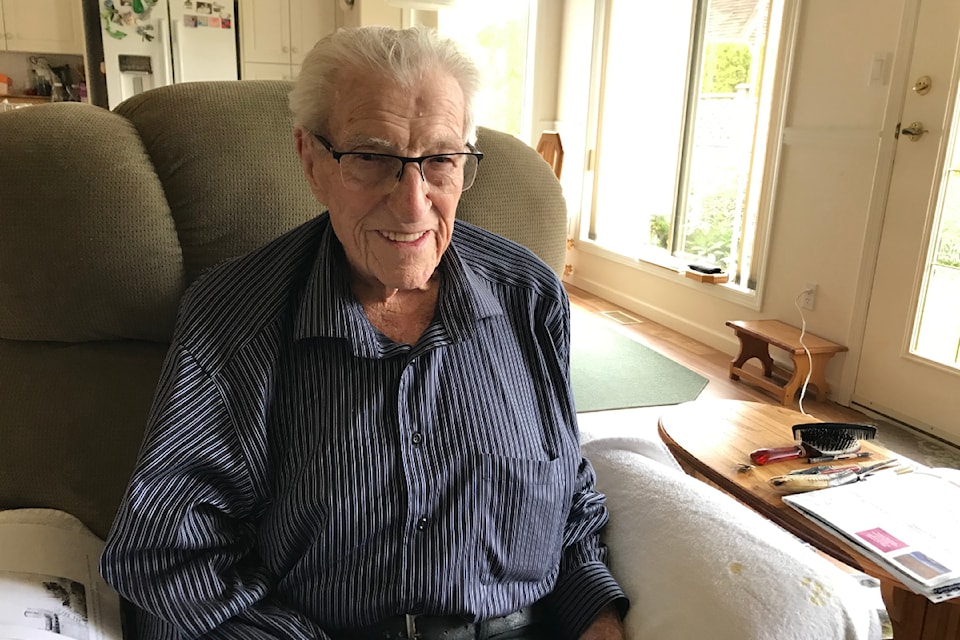Qualicum Beach merchant mariner Clifford Brown still remembers the sounds and sights of a huge waterfront explosion in Vancouver's harbour nearly 80 years ago.
The SS Greenhill Park, a 10,000-pound freighter, blew up on March 6, 1945. The ship's cargo of sodium chlorate, signal flares and liquor, some of which was spilled, exploded when someone lit a match, according to the Vancouver Maritime Museum.
Brown recalled planes flying overhead, and in the fog and confusion, it seemed like an enemy attack.
“We didn’t know what the hell was going on," he said. "We didn’t know if it was being torpedoed or what. We were there ready to discharge.”
He was just coming off his watch and noticed what appeared to be snowflakes falling all around him. It turns out they were bits and pieces of mantles that had covered gas lanterns.
Brown's brother was across the shipyard on his way with a group of men to rig a ship.
“He was halfway across when she blew up," he said. “If he waited another half hour, he would have been on the ship and they would have got hurt.”
The explosion killed eight servicemen and injured 26 others, including seven firefighters who ended up in hospital. Windows were shattered across entire office blocks — Brown recalled the windows of the old Birks Building being blown out.
He'd joined the Merchant Navy a few years prior. At 17 years old, he was too young for the Navy and did not want to wait and be drafted into the Army. It was also the best way for him to get his "mate's ticket".
Brown sailed with his father from a young age, so he was accustomed to being on the water.
“My dad was a sea captain, so I was following his footsteps,” he said.
He served on several freighters over the course of about four years as a quartermaster, helping to steer the ship with the use of a compass.
While aboard ships like the SS Gray and the SS Southholm, the crews would transport essential materials for the war effort, like dynamite, pulp, ammunition, building materials and heavy duty trucks, making stops at ports in Skagway, Alaska, Port Rupert and Tacoma, Wash.
“We took a lot of equipment like trucks out of Alaska and took them to Prince Rupert," he said. "And then they got the train there and went down south, because they were building the Alaska Highway.”
The ship was outfitted with a cannon on the back and two machine guns up on the bridge, but they never fired outside of practice.
Brown only got seasick once, on his first voyage, but it was an issue for many others.
“I took over one time — this quartermaster got seasick and he vomited in the binnacle," he said. “He was sick and instead of going out on the boat and throwing up, he was sick and he puked on the compass and that’s enough to make anybody sick.”
It was a dangerous job and although the possibility of a Japanese submarine was an ever-present threat, it was a massive wave that put Brown's crew in jeopardy at the top end of Vancouver Island, on a run to Port Alice.
“I’ve never seen the sea that big," he said. "You looked up and you saw the top of it coming down, and it hit the deck, and you couldn’t see anything on the deck — just water all over.”
The wave hit the SS Southholm hard enough to stop its engines before turning the ship broadside.
“It was a little scary because we were out in the Pacific," he said. “We didn’t know what to do. It turned the stove upside down — burned the cook pretty bad.”
They managed to restart the engines, turn the ship around and haul their load to its destination. It was fortunate they were travelling through the calmer Strait of Georgia on their way back.
"We limped back to Victoria and they gave us all $5 and told us to go home. How’d you like that?” Brown said with a chuckle. “The ship never sailed after that. It was finished."
After four years on the sea, he'd had enough and it was time for a new job.
“It was a toss up whether to go in the police force or to go in the newspaper, and I thought, well, the newspaper sounds pretty good.”
Brown worked in distribution for the Vancouver Sun for 47 years, looking after the Island. He moved to Vancouver Island in the early 1960s and lived in Deep Bay for decades, where he became a member of Bowser Royal Canadian Legion Branch 211, before moving to Qualicum Beach.
He still loved boats and built a fishing vessel for a hobby while he lived in Deep Bay, a place he became familiar with during the war.
"Nobody knew anything about Deep Bay in those days, but we ran in there during the war, so I knew quite a bit about it and I thought, 'geez this would be a nice place to live when it's all over.'"



